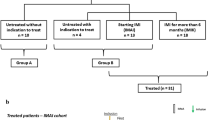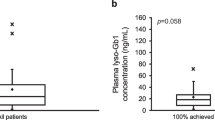Abstract
Background
Enzyme replacement therapy (ERT) is currently the standard treatment for patients with Gaucher disease type I (GD1), but the pharmacokinetics have hardly been studied. This study aimed to quantify in vivo enzyme activity in peripheral leukocytes from patients receiving long-term treatment with imiglucerase or velaglucerase for GD1, and set out to assess the process of enzymatic uptake by peripheral leukocytes.
Methods
A prospective semi-experimental study was conducted. Four time points for blood withdrawal were planned per patient to quantify the intra-leukocyte enzymatic activity. In order to assess the uptake process, the rate of enzyme uptake by leukocytes (Rupt) and the rate of enzyme disappearance from the plasma (Rdis) were estimated.
Results
Eight GD1 patients were included. Intra-leukocyte activity was 24.31 mU/mL [standard deviation (SD) 6.32 mU/mL; coefficient of variation (CV) 25.96 %] at baseline and 27.14 mU/mL (SD 6.96 mU/mL; CV 25.65 %) at 15 min post-perfusion. The relationships with the administered dose were linear. The Rupt value was 37.73 mU/mL/min [95 % confidence interval (CI) 25.63–49.84] and showed a linear correlation with the administered enzyme dose (p < 0.05), and the Rdis value was 189.43 mU/mL/min (95 % CI 80.31–298.55) and also showed a linear correlation with the dose (p < 0.05).
Conclusion
This was the first in vivo study to quantify the accumulated enzymatic activity in patients receiving ERT for GD1. It showed that intra-leukocyte activity at baseline and at 15 min post-perfusion could be used as a possible marker for therapeutic individualization in patients receiving ERT for GD1.





Similar content being viewed by others
References
Grabowski GA. Gaucher disease: enzymology, genetics, and treatment. Adv Hum Genet. 1993;21:377–441.
Pastores GM, et al. Therapeutic goals in the treatment of Gaucher disease. Semin Hematol. 2004;41(4 Suppl 5):4–14.
Beutler E, Grabowski GA. Gaucher disease. In: Scriver C, Beaudet AL, Sly WS, Valle D, editors. The metabolic and molecular bases of inherited disease. 8th ed. Vol. III. New York: McGraw-Hill; 2011. p. 3635–3668.
Vellodi A, et al. Management of neuronopathic Gaucher disease: a European consensus. J Inherit Metab Dis. 2001;24(3):319–27.
Beutler E, et al. The clinical course of treated and untreated Gaucher disease: a study of 45 patients. Blood Cells Mol Dis. 1995;21(2):86–108.
Brady RO. Gaucher’s disease: past, present and future. Baillieres Clin Haematol. 1997;10(4):621–34.
Bodamer OA, Hung C. Laboratory and genetic evaluation of Gaucher disease. Wien Med Wochenschr. 2010;160(23–24):600–4.
Beutler E, Kuhl W. Detection of the defect of Gaucher’s disease and its carrier state in peripheral-blood leucocytes. Lancet. 1970;1(7647):612–3.
Beutler E, Kuhl W. The diagnosis of the adult type of Gaucher’s disease and its carrier state by demonstration of deficiency of beta-glucosidase activity in peripheral blood leukocytes. J Lab Clin Med. 1970;76(5):747–55.
Pharmaceuticals Shire. Vpriv (velaglucerase): European public assessment report. London: European Medicines Agency; 2010.
Europe Genzyme. Cerezyme (imiglucerase): European public assessment report. London: European Medicines Agency; 1997.
Giraldo P. Guidelines for type 1 Gaucher’s disease. Med Clin (Barc). 2011;137(Suppl 1):55–60.
Zimran A. How I treat Gaucher disease. Blood. 2011;118(6):1463–71.
Zimran A, Elstein D, Beutler E. Low-dose therapy trumps high-dose therapy again in the treatment of Gaucher disease. Blood. 2006;108(3):802–3.
Figueroa ML, et al. A less costly regimen of alglucerase to treat Gaucher’s disease. N Engl J Med. 1992;327(23):1632–6.
Beutler E. Treatment regimens in Gaucher’s disease. Lancet. 1995;346(8974):581–2.
Kishnani PS, et al. A randomized trial comparing the efficacy and safety of imiglucerase (Cerezyme) infusions every 4 weeks versus every 2 weeks in the maintenance therapy of adult patients with Gaucher disease type 1. Mol Genet Metab. 2009;96(4):164–70.
Ben Turkia H, et al. Velaglucerase alfa enzyme replacement therapy compared with imiglucerase in patients with Gaucher disease. Am J Hematol. 2013;88(3):179–84.
Elstein D, et al. Booster-effect with velaglucerase alfa in patients with Gaucher disease switched from long-term imiglucerase therapy: early access program results from Jerusalem. Blood Cells Mol Dis. 2012;48(1):45–50.
van Dussen L, et al. Effects of switching from a reduced dose imiglucerase to velaglucerase in type 1 Gaucher disease: clinical and biochemical outcomes. Haematologica. 2012;97(12):1850–4.
Zimran A, et al. A pharmacokinetic analysis of a novel enzyme replacement therapy with gene-activated human glucocerebrosidase (GA-GCB) in patients with type 1 Gaucher disease. Blood Cells Mol Dis. 2007;39(1):115–8.
Friedman B, et al. A comparison of the pharmacological properties of carbohydrate remodeled recombinant and placental-derived beta-glucocerebrosidase: implications for clinical efficacy in treatment of Gaucher disease. Blood. 1999;93(9):2807–16.
Pocovi M. Molecular basis of treatment in Gaucher’s disease. Med Clin (Barc). 2011;137(Suppl 1):32–8.
Kornfeld S. Trafficking of lysosomal enzymes in normal and disease states. J Clin Invest. 1986;77(1):1–6.
Brumshtein B, et al. Characterization of gene-activated human acid-beta-glucosidase: crystal structure, glycan composition, and internalization into macrophages. Glycobiology. 2010;20(1):24–32.
Colomer EG, et al. Development and application to clinical practice of a validated HPLC method for the analysis of beta-glucocerebrosidase in Gaucher disease. J Pharm Biomed Anal. 2014;91:123.
Committee for Medicinal Products for Human Use. Assessment report. Elelyso: taliglucerase alfa. London: European Medicines Agency; 2012. http://www.ema.europa.eu/docs/en_GB/document_library/EPAR_-_Public_assessment_report/human/002250/WC500135112.pdf. Accessed 14 Mar 2016.
Pandey MK, Grabowski GA. Immunological cells and functions in Gaucher disease. Crit Rev Oncog. 2013;18(3):197–220.
Blanz J, et al. Disease-causing mutations within the lysosomal integral membrane protein type 2 (LIMP-2) reveal the nature of binding to its ligand beta-glucocerebrosidase. Hum Mol Genet. 2010;19(4):563–72.
Acknowledgments
We thank the patients with GD and health care personnel from Pharmacy and Hematology Service.
Author information
Authors and Affiliations
Corresponding author
Ethics declarations
Conflict of interest
Elena Gras-Colomer, María Amparo Martínez-Gómez, Ana Moya-Gil, Miguel Fernandez-Zarzoso, Matilde Merino-Sanjuan and Mónica Climente-Martí have no conflicts of interest that might be relevant to the content of this manuscript.
Funding
This work was supported by Foundation for the Promotion of Health and Biomedical Research in the Valencian Community (FISABIO).
Rights and permissions
About this article
Cite this article
Gras-Colomer, E., Martínez-Gómez, M.A., Moya-Gil, A. et al. Cellular Uptake of Glucocerebrosidase in Gaucher Patients Receiving Enzyme Replacement Treatment. Clin Pharmacokinet 55, 1103–1113 (2016). https://doi.org/10.1007/s40262-016-0387-2
Published:
Issue Date:
DOI: https://doi.org/10.1007/s40262-016-0387-2




